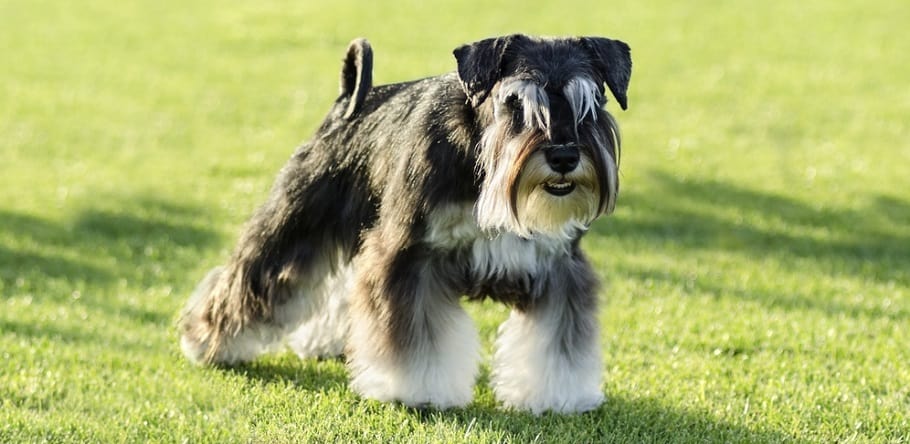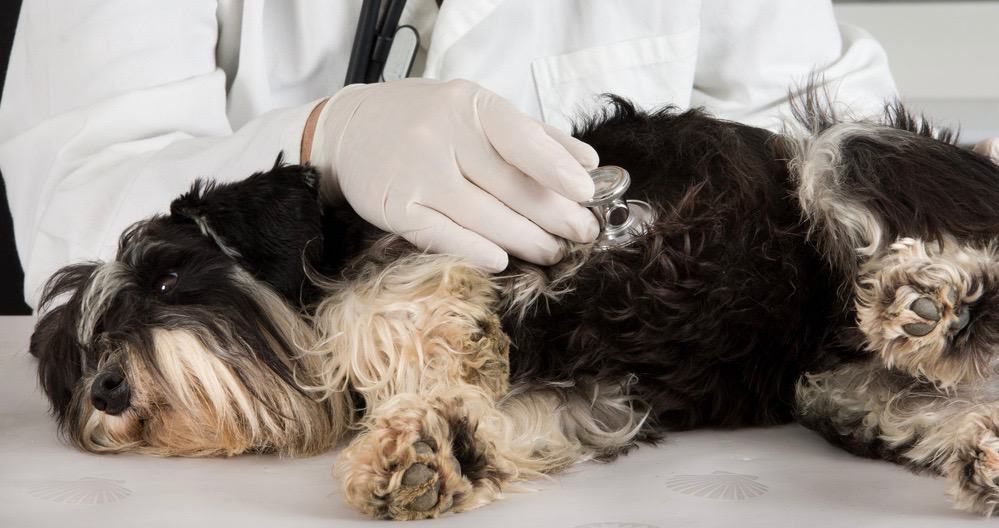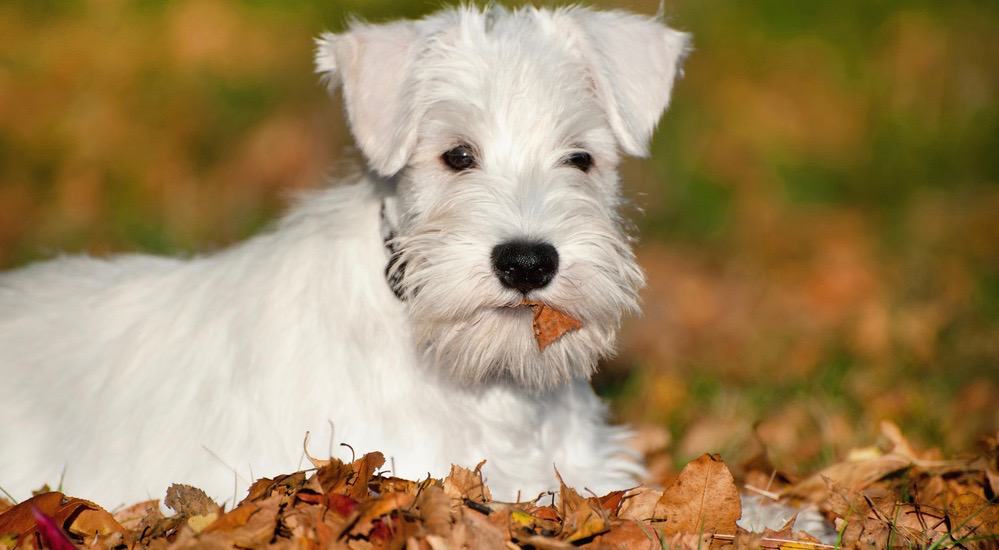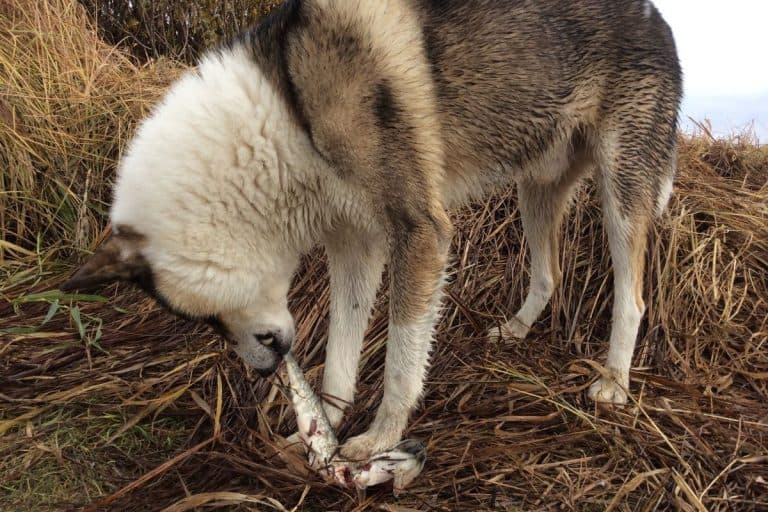Miniature Schnauzer Growth Chart – Weight & Size Chart
Miniature Schnauzers are little dogs with big hearts. They are known to be robust and spirited with wiry coats that come in three distinct color patterns. These are salt and pepper, black and silver, and solid black.
As a dog parent or prospective dog parent of a miniature schnauzer, a Miniature Schnauzer growth chart will be helpful, to monitor their growth.
Miniature schnauzers are usually around 12 to 14 in height at adulthood, and they were bred from the standard schnauzers, with which they share many similarities.
They have bushy beards and eyebrows making them appear almost human-like.
Miniature schnauzers are sturdy despite their small size, and they enjoy high-energy activities.
They are also home and family-oriented because they are excellent watchdogs who adapt to apartment life or large spaces. They also take training well.
When Do Miniature Schnauzers Stop Growing?

Miniature schnauzers usually attain their full size at 12 months of age, which is around two months later than the average rate for dogs of that size. They should make the switch from puppy food to adult food at this time.
As their name suggests, miniature schnauzers are admittedly small, especially when compared to other schnauzers and other breeds.
Adult male and female miniature schnauzers normally weigh approximately 13 to 15 pounds and stand at 12 to 14 inches in height.
Miniature schnauzers usually have increased caloric needs as puppies. When they are about 12 months of age, their caloric should begin to match adult dogs.
Miniature Schnauzer Size Chart
The Miniature Schnauzer weight chart below displays the relative size of your miniature schnauzer’s and weight throughout the stages of development.
If your dog’s weight is not exactly the same as the chart, there is usually no need for alarm as every dog is different.
We can’t give a definite determination of the adult size of a puppy. The Miniature Schnauzer growth chart gives you an estimate of your puppy’s adult size based on the standard at that age.
However, remember that if you find your miniature schnauzer’s weight is a lot less than on the chart, you need to look at his overall health and wellbeing.
You can relax if your miniature schnauzer’s weight is a bit more than any of the numbers in the chart.
If he has a few extra pounds over the stated range it is perfectly acceptable, not all miniature schnauzers may fall within the established range.
It is advised that you always check with your veterinarian if you ever have doubts and notice anything peculiar.
You can use this Miniature Schnauzer puppy weight chart as a reference point, but be aware that the numbers are not applicable to every dog. You may have a better view of his overall health because you are in a better position to anticipate his needs.
Miniature Schnauzer Weight Chart
| Age | Female Weight | Male Weight |
|---|---|---|
| 3 months | 5.3 lbs - 7.9 lbs | 5.3 lbs - 8.7 lbs |
| 4 months | 7 lbs - 10.4 lbs | 7 lbs - 11.8 lbs |
| 5 months | 8.6 lbs - 12.7 lbs | 8.5 lbs - 13.9 lbs |
| 6 months | 9.5 lbs - 14.1 lbs | 9.5 lbs - 15.7 lbs |
| 7 months | 10.3 lbs - 15.5 lbs | 10.5 lbs - 17.2 lbs |
| 8 months | 10.8 lbs - 16.4 lbs | 10.8 lbs - 18.1 lbs |
| 9 months | 11.2 lbs - 17.1 lbs | 11.2 lbs - 18.9 lbs |
| 10 months | 11.6 lbs - 17.5 lbs | 11.5 lbs - 19.5 lbs |
| 11 months | 11.6 lbs - 17.9 lbs | 11.5 lbs - 19.9 lbs |
| 12 months | 11.9 lbs - 18.1lbs | 11.9 lbs - 20.1 lbs |
Miniature Schnauzer Growth Chart – What To Expect

Birth – 2 Weeks
When your Miniature schnauzer puppies are just born, they are in need of their mother’s milk and warmth. Their eyes are still closed, and they will spend most of their time nursing and sleeping until they gain their strength.
Their senses of touch, smell, and taste are present, but they can’t yet hear or see. Moreover, because of their undeveloped muscles, they can’t yet walk. They will weigh between 4 and 9 ounces and will be about 3 to 7 inches long at birth, but they will double their birth weight in these first two weeks.
3 Weeks – 12 Weeks
At this time, your Miniature schnauzer will begin to use his sense of hearing and open his eyes. He will begin to gain muscles that are sturdy and allow him to stand up, play with his siblings, run, and bark. His teeth will also start to appear.
As his eyesight grows, he will slowly start to be informed of his surrounding conditions as well as get control over his bowel movement and bladder. At 2 months old, puppies will again double their size and weigh about 3 to 5 pounds.
4 Months – 9 Months
During this phase of life, his adult teeth begin to set, and he will want to sharpen them. So to save yourself some trouble, you should invest in some chew toys, before he chews important things he finds.

You are now the main person in the life of your puppy, and you should spend quality time with him to create a strong bond. He will continue to grow and at 6 months, your Miniature Schnauzer will have reached 75% – 85% of his full-grown weight.
10 Months – 18 Months
During this period, your Miniature schnauzer will reach sexual maturity and pass through drastic hormonal shifts. These hormonal changes happen a bit differently in male and female dogs.
The male dogs are sexually active all throughout the year while female dogs that are going through sexual maturity usually enter their heat cycle around twice per year, and it lasts about 2-3 weeks. Your miniature Schnauzer may only gain an added few pounds, as he reaches his full size.
Adult
Miniature schnauzer will reach adulthood when they are around one year old which is a bit faster than dogs this size. At this age, they usually attain most of their development and are still very active, although their heart rate slows and are a bit less playful.
They still need proper nutrition so that they can develop muscles and healthy bones. You can also help to achieve this by engaging them in exercise.
Miniature Schnauzer Height Chart
A height chart will work in the same way that a weight chart works. You can measure your own dog’s height, locate the heights of dogs of the same sex and age, and see where your dog is as far as averages go.
Funnily enough, Miniature Schnauzer males and females are the same size.
To measure your Miniature Schnauzer, you need to have him stand on all four legs. Then, measure from the top of his shoulder down to the ground.
On average, an adult Miniature Schnauzer is between 12 and 14 inches tall, regardless of sex.
How Big Do Miniature Schnauzers Get?

The best way to know how big do Miniature Schnauzers get is going to get is to consult with a Miniature Schnauzer size chart.
That way, you can follow what the growth trends look like for how big your dog is now compared to the average size.
Beyond the growth chart, if you know the dog’s parents, you can look at them and get a general idea of how big your dog is likely to get.
Looking at paw size is another trick, but it might not work as well with a smaller dog like a Miniature Schnauzer. Otherwise, you can always look into a DNA test.
Will Neutering/Spaying Affect My Miniature Schnauzer’s Growth?
It used to be standard to spay or neuter your puppy when he has reached about 6 months old.
This was the typical way of doing things if you had no intention of ever breeding or showing your dog, since it is a great way to keep down the animal population. But, more recent science has suggested against doing it so early.
Spaying and neutering your dog young will not cause them to be shorter or weigh less than they would have otherwise.
Yet, recent studies have shown that it can affect the growth of joints, especially in large breeds, causing mobility issues as they age. Ask your vet for her recommendation for your Miniature Schnauzer, since it is not a large breed.
How To Properly Weigh And Measure A Miniature Schnauzer?
Keeping track of your dog’s weight is good for a lot of reasons; including making sure he is not gaining too much weight or that he is growing on track.
Since the breed is not very big, it is easy to weigh and measure your dog at home, but you can always have your vet do it as well.
To weigh your dog at home, you only need to use a human scale. Weigh yourself first and jot it down.
Then, pick up your Miniature Schnauzer and weigh yourself again. The difference in the two weights will be the weight of your Miniature Schnauzer. To measure his height, just use a tape measure and measure from the highest point on his back to the ground.
Scottish Terrier vs Miniature Schnauzer Size
There is a similar appearance between a Miniature Schnauzer and a Scottish Terrier, so it is natural to wonder whether there is a size difference between the two breeds. There is a difference, but it is not large.
While the Miniature Schnauzer is between 12 and 14 inches tall, a Scottish Terrier, on average, stands only 10 inches tall. Weight-wise, the Scottish Terrier is usually heavier.
A male Scottish Terrier weighs between 19 to 22 pounds and a female weighs between 18 and 21 pounds, compared to the 11 to 20 pounds a Miniature Schnauzer weighs.
What Is A Miniature Schnauzer’s Neck Size?
You might not have considered measuring your Miniature Schnauzer’s neck size, but it is a good idea.
Knowing the current neck size of your dog will help you to buy an appropriately-sized collar for your dog. If a collar is too loose, it will slip off and too tight will be constricting.
On average, an adult Miniature Schnauzer’s neck is between 10 and 16 inches.
If you have a puppy, remember that the puppy will outgrow his collar relatively quickly so you need get a collar that fits, but is also adjustable as your puppy grows.
Factors That Affect Miniature Schnauzer Puppy Growth

Genetics
Your dog’s parents play an indispensable function in his existing physical health due to those genes are transferred to him. The ancestor’s health can determine your dog’s ability to develop as well as his inclination to get certain illnesses.
Hereditary traits have a notable influence on a Miniature schnauzer’s growth as they were bred to be smaller. These physiological factors establish the growth rate as well as other important factors which add to their advancement.
Nutrition
As a dog parent, you should attempt to offer your dog the best foods available on the market because the poor quality foods that fail to provide nutrients can seriously affect his health and lifespan.
Your dog’s nutrition influences his growth as well as his overall quality of life. The food you feed your Miniature schnauzer puppy will affect his ability to grow.
His growth will be thwarted if you always give him low-quality food that doesn’t have the proper minerals and vitamins he needs to meet developmental milestones.
Physical Activity & Health
Miniature schnauzers enjoy being active. They need physical activity for proper growth and bone density to happen. Your puppy will grow naturally and meet his developmental milestones.
He will have an athletic body that will add weight to your puppy while keeping him healthy. Your Miniature schnauzer will also have a better overall mood if you engage them in frequent physical activity.
How Long Are Miniature Schnauzers Pregnant?
Miniature Schnauzers tend to carry their puppies for approximately between 56 and 66 days before they give birth.
The standard time is roughly two months; there will be very little or no visible signs that your dog is pregnant within the first weeks of pregnancy. During this time, there will be internal changes that occur internally within the uterus.

After this, you will notice that her nipples will become larger, turn darker, and there will be some visible hair loss around her breasts. You need to take your miniature schnauzer to the vet to ensure that she is healthy throughout the pregnancy.
How Many Puppies Do Miniature Schnauzers Have?
Miniature Schnauzers have an average of 6 puppies per litter. Birth complications are typical for this breed and the number of c-sections is known to be above average.
Since C-Sections are commonly needed in the whelping of Giant Schnauzer pups, you should always consult your vet.
Litter sizes can range on the lower end for smaller dogs. There are a variety of factors that affect the litter size of your miniature schnauzer, such as diet and physical activity levels.
There are also genetic factors that determine overall health and propensity to disease. Do your best to ensure that your dog is healthy.
What If My Miniature Schnauzer Is Not The Right Weight
If your miniature schnauzer is overweight, you should consider an increase in physical activities or adjustment in diet. You will know he is overweight if you can run your hand along his rib cage and not readily feel his ribs without much effort.

There are a variety of reasons why your schnauzer may be too thin. There may be a problem with intestinal parasites, or he may not be receiving sufficient nutrients from the food he is given.
He may also have a problem with his liver, intestines, or kidneys. In any case, it is always good to check with the vet to ascertain the problem.
What Is The Life Expectancy Of Miniature Schnauzers?
The average lifespan of a Miniature Schnauzer is 12 years. Generally, smaller dogs often live longer than their larger canine counterparts, especially when compared to purebred dogs.
You can prolong your Miniature Schnauzer’s lifespan by having him bred only from the healthiest parents for good genes and giving him a lifetime of good care.
The reason for this longer lifespan is mainly due to size, as small breeds tend to live longer, while giant breeds usually have shorter lives.
There is also the determinant of the dog’s features. These cover issues like the shape of their faces (flat or protruded) and the length of their backs, to name a few.
How Much Does It Cost To Own A Miniature Schnauzer?
You are likely to pay around $600-$1,800 with the average price being $950 for a Miniature Schnauzer puppy. For the first year, the cost is approximately $3,540 and around $1,170/year, then on. The cost for the month is approximately $98.
The average cost of having a Miniature Schnauzer is $18,750 throughout his lifetime.
Dog parents should be relieved that the Miniature Schnauzer is a smaller dog and will require less food.
Additionally, when they maintain a healthy, high-quality diet and given proper exercise and preventative care, it will cost you less in medical costs compared to a larger dog.

Miniature Schnauzer Genetics And Common Health Problems
Miniature Schnauzers are usually affected by a variety of health problems including diabetes, epilepsy, allergies, and pancreatitis.
The most common genetic problem of the breed is a marked inclination to form various types of bladder stones, normally struvite or calcium oxalate stones.
Experts believe that they happen so frequently in the Miniature Schnauzer due to a breed-related weakness of the urinary tract.
Struvite stones are typically caused by bladder infections. After the bladder infection is treated with antibiotics, the stones tend to go away, but they may occasionally require surgery.







